|
|
|
Sort Order |
|
|
|
Items / Page
|
|
|
|
|
|
|
| Srl | Item |
| 1 |
ID:
159763


|
|
|
|
|
| Summary/Abstract |
This article presents an analysis of South Korea’s strategic choices over the Asian Infrastructure Investment Bank (AIIB), the Trans-Pacific Partnership (TPP), and the Terminal High Altitude Area Defense (THAAD) in light of the Sino–US competition in post-Cold War East Asia. South Korea’s puzzling behavior here represents Seoul’s hedging strategy against the uncertain future of the Sino–US competition in East Asia. The driving force of South Korea’s hedging behavior is Seoul’s dual concerns about being excessively dependent on the USA for its security at the time of China’s rapid rise on the one hand and being pulled into a growing China’s sphere of influence at the expense of traditional US–ROK security ties on the other. Reflecting Seoul’s prudent balancing acts between the two superpowers, South Korea’s hedging often results in apparently indecisive and underdetermined strategic choices in the face of the intensifying Sino–US competition. Nevertheless, South Korea’s hedging strategy allows Seoul to deepen extensive economic ties with Beijing while maintaining a traditional security alliance with Washington. The hedging behavior of South Korea, which is uniquely positioned as a strategic partner of rapidly rising China as well as a key security ally of the rebalancing USA, sheds important light on the behavior of middle powers in alliance politics, which has largely been neglected in the current literature.
|
|
|
|
|
|
|
|
|
|
|
|
|
|
|
|
| 2 |
ID:
158731
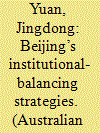

|
|
|
|
|
| Summary/Abstract |
China has in recent years been actively engaged in multilateral diplomacy. From the Shanghai Cooperation Organisation and the Conference on Interaction and Confidence Building Measures in Asia to the Asian Infrastructure Investment Bank and the One Belt, One Road initiative, Beijing is pursuing strategies and promoting norms that are viewed as concerted efforts by China to challenge some of the key institutional arrangements of the existing international order. This article seeks to discuss these contentious issues and assess the rationales, approaches and implications of Chinese diplomacy in initiating and promoting what can be considered as institutional-balancing strategies. The author suggests that the rationales behind these Chinese strategies have as much to do with Beijing’s shifting priorities and the need to address them as with reflecting a degree of dissatisfaction with existing multilateral institutions. And there are more marked differences in Chinese motivations and modalities in security arenas than in economic areas. However, it would be overstating Beijing’s intentions and capabilities if these China-sponsored initiatives are viewed as direct challenges to the existing international and regional orders.
|
|
|
|
|
|
|
|
|
|
|
|
|
|
|
|
| 3 |
ID:
106375
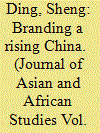

|
|
|
|
|
| Publication |
2011.
|
| Summary/Abstract |
National image is not only a channel to wield a state's national power, but also an important national power resource. It has become critically important for China as it tries to rise in a relatively favorable international environment. Following a theoretical discussion on national image management in international relations and a historical review of China's national image management, this article examines China's strengths and weaknesses in its national image management. On the one hand, China's national image benefits from its strong commitment to cultural diplomacy, effective employment of information and communication technologies in international broadcasting, and close connections with the Chinese diaspora around the world. On the other hand, China's national image management is constrained by such hurdles as weak political credibility, reviving popular nationalism, and various missteps in its foreign policies. This study concludes that China's national image management will remain an uphill battle in the long run.
|
|
|
|
|
|
|
|
|
|
|
|
|
|
|
|
| 4 |
ID:
144795
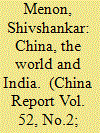

|
|
|
|
|
| Summary/Abstract |
After more than three decades of stupendous growth, China is in the process of making the painful transition to a lower growth path. As it does so, the ruling CPC is increasingly turning to nationalism to provide legitimacy in the eyes of its own people. China now openly seeks to ‘display its prowess’ and ‘assume its responsibilities’ in the world. However, it still lacks the capability to impose a political or security order of its own in its immediate neighbourhood. There is, therefore, likely to be a period of instability in the Asia–Pacific region, and the environment in which India pursues its interests will get more complex. China and India today have a relationship with elements of both cooperation and competition. While both countries have a common interest in improving on the existing security and economic order, they compete in the periphery they share. A danger present in present-day India–China relations comes from the mutual gap between perception and reality. Nevertheless, this article argues that this is a moment of opportunity for India–China relations, and that each country could benefit its core interests by working with the other.
|
|
|
|
|
|
|
|
|
|
|
|
|
|
|
|
| 5 |
ID:
143934
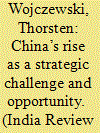

|
|
|
|
|
| Summary/Abstract |
The simultaneous rise of China and India is one of the most important developments in contemporary world politics. Given their steadily growing power and aspirations and China’s more assertive posture in Asia, the management of China’s rise is one of the major challenges for India’s foreign policy. However, India is often said to have no guiding strategic framework for its China policy, which is seen as incoherent and reactive. This article, by contrast, shows that India has an evolving China strategy and that the alleged inconsistencies in India’s China policy are rather the result of an ambivalent image of China. Drawing on constructivism and discourse analysis, the article identifies the dominant perception of China in India’s foreign policy discourse and the resulting foreign policy strategy. In a next step, the article analyzes the China policy of the Congress-led UPA Government and investigates whether it conforms to the strategic policy frame of the dominant China discourse.
|
|
|
|
|
|
|
|
|
|
|
|
|
|
|
|
| 6 |
ID:
176005
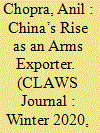

|
|
|
|
|
| Summary/Abstract |
The Chinese arms industry today is the world’s second-largest producer of munitions. It has overtaken Russia in arms production, a country that was once a major supplier of arms to China. Currently, three of the world’s top 10 arms companies are Chinese. China is also becoming a significant exporter of arms around the world. It has emerged as a supplier of weapon platforms to over 50 countries, and is now the world’s fifth largest arms exporter.
|
|
|
|
|
|
|
|
|
|
|
|
|
|
|
|
| 7 |
ID:
161575
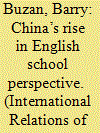

|
|
|
|
|
| Summary/Abstract |
This chapter looks at English School (ES) theory as a way of understanding China and its rise. It focuses both on where ES theory fits well enough with China to provide an interesting perspective, and on where ‘Chinese characteristics’ put China outside the standard ES framing and raise theoretical challenges to it. The first section briefly reviews the ES literature on China. The second section places China within the normative structure of contemporary global international society by looking at how China relates to the primary institutions that define that society. The third section explores two challenges that ‘Chinese characteristics’ pose for how the ES thinks about international society: hierarchy and ‘face’. The Conclusions assess the strengths and weaknesses of ES theory in relation to understanding the rise of China.
|
|
|
|
|
|
|
|
|
|
|
|
|
|
|
|
| 8 |
ID:
120199
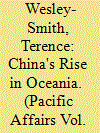

|
|
|
|
|
| Publication |
2013.
|
| Summary/Abstract |
This paper identifies a broad context for assessing China's increased interest in the Pacific Islands, and examines some of the major implications for regional security, regional politics, western influence, and self determination in the region. It argues that Beijing's policy towards the Pacific is not driven by strategic competition with the United States, as some have maintained. Nor is it reducible to a specific set of interests centered on natural resources and, especially, competition with Taiwan. Although these factors are important, China's activities in the region are best understood as part of a much larger outreach to the developing world that is likely to endure and intensify. The paper suggests that China's rise is generally welcomed by island leaders, and makes the case that it offers island states economic and political opportunities not available under established structures of power and influence.
|
|
|
|
|
|
|
|
|
|
|
|
|
|
|
|
| 9 |
ID:
187400


|
|
|
|
|
| Summary/Abstract |
Challenging a popular view that China’s rise will lead the United States and China to fall into the ‘Thucydides trap’—a possible hegemonic war between the two—this paper proposes an ‘institutional peace’ argument, suggesting that the ongoing international order transition will be different from previous order transitions in history. Instead of using military means to change the international order, China and the United States have relied on various institutional balancing strategies to compete with one another for an advantageous position in the future international order. The discussion on the institutional competition between China and the US around the AIIB and the ARF-related multilateral security architecture supports the ‘institutional peace’ argument: institutional competition in the form of institutional balancing strengthens the dynamics and utility of international institutions, encourages states to offer new public goods, and could lead to a more peaceful order transition in the international system. However, this institutional peace argument is constrained by two caveats: the continued validity of the MAD nuclear deterrence and a limited degree of ideological antagonism between the US and China.
|
|
|
|
|
|
|
|
|
|
|
|
|
|
|
|
| 10 |
ID:
164829
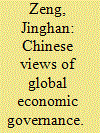

|
|
|
|
|
| Summary/Abstract |
China’s rise and America’s global retreat have made China’s role in global governance more important than ever before. By analysing Chinese (mainly academic) literature, this article studies contemporary Chinese views of global economic governance. It finds that the 2008 financial crisis is a notable point of the Chinese discourse. In addition, dialogue platforms – the G20 in particular – rather than key institutions of global economic governance such as International Monetary Fund (IMF), World Bank and Word Trade Organization (WTO) win overwhelming attention in the Chinese discourse. Chinese views of global economic governance also highly value the role of the state, while paying less attention to Non Governmental Organisations (NGO) and civil society. Overall, this article highlights a diverse, shifting and sometimes contradictory Chinese discourse on global economic governance, which helps to develop a more accurate understanding of China’s ambition in global economic governance.
|
|
|
|
|
|
|
|
|
|
|
|
|
|
|
|
| 11 |
ID:
170520
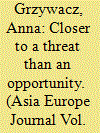

|
|
|
|
|
| Summary/Abstract |
Chinese initiatives of a geopolitical nature are being more and more frequently analyzed in the literature. At the same time, it is pointed out that at least since 2012 China has been pursuing an assertive and active foreign policy. Due to the importance of the Belt and Road Initiative project and also the 16 + 1 cooperation in the Central and Eastern Europe region, it is worth analyzing what the perception of China in this region is on the example of Poland. The study attempts to answer the question of how the increase in China’s importance and its international engagement are perceived in Poland. The analysis of Polish papers published in 2003–2017 shows, and this is an argument, that Polish researchers more frequently present China in the categories of a threat and apply research terminology and tools within the realistic theory of international relations and this image is being reinforced, especially after 2013. The analytical framework of “China as a threat” and “China as an opportunity” occurring frequently in research is placed in this paper in theories of international relations.
|
|
|
|
|
|
|
|
|
|
|
|
|
|
|
|
| 12 |
ID:
146902
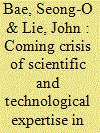

|
|
|
|
|
| Summary/Abstract |
South Korea has shifted from a relatively well-educated but poorly remunerated workforce to a highly skilled and compensated one in high-value-added industries. This paper analyzes the South Korean government’s science and technology policy and the supply of scientists and engineers in emerging industries. We note a potential shortfall of skilled talent in the near future.
|
|
|
|
|
|
|
|
|
|
|
|
|
|
|
|
| 13 |
ID:
179179


|
|
|
|
|
| Summary/Abstract |
China’s economy has doubled in size every eight years since 1979, making it over 32 times bigger now then it was then and the second largest in the world today.1 Four decades of growth have ushered more than 400 million people in China into the global middle class.2 According to the World Bank, China is currently an upper middle-income country. The country is the only major economy on earth to report growth in 2020 in the wake of the coronavirus pandemic.3 What are the prospects for China to continue its spectacular economic rise and become a high-income country? In this article, we aim to draw attention to an underappreciated factor that we believe may complicate China’s continued economic ascent: hundreds of millions of poorly educated, increasingly underemployed workers hailing from China’s rural hinterland.
|
|
|
|
|
|
|
|
|
|
|
|
|
|
|
|
| 14 |
ID:
131820
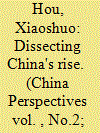

|
|
|
|
|
| Publication |
2014.
|
| Summary/Abstract |
The recent discussion of a "Beijing Consensus" and a China model seems to challenge neoliberalism as the dominating discourse on development. This paper attempts to explain the contradictions in China's development and discusses whether and how they can be redressed. Specifically, the paper analyses the key issues around the debate over the China model - how distinctive it is and whether it can be replicated elsewhere, and what real lessons can be drawn from China's rise. It proposes a more nuanced view of the economic, social, and political structures in China with a focus on its mixed economy, the role of the state at both the central and local levels, and the possibility of Chinese-style democracy. It also offers suggestions for improving the China model.
|
|
|
|
|
|
|
|
|
|
|
|
|
|
|
|
| 15 |
ID:
152941


|
|
|
|
|
| Summary/Abstract |
How should Europe respond to China’s growing economic and military capabilities, and to the more assertive foreign policy behavior it has generated? Should it seek to check or even resist China’s rise, or should it instead rely on a strategy of engagement and accommodation? Three distinct and coherent strategic visions exist that could guide Europe’s policy and strategy toward China and the Asia Pacific over the next 10 or 15 years. These range from narrow commitments to Europe’s own security and material prosperity to more ambitious and expansive efforts to shape and influence events in the Asia Pacific. These three strategic visions are (1) balancing, (2) engagement, and (3) retrenchment. After outlining and evaluating each strategic vision, this article then offers a brief review and analysis of Europe’s current approach toward China, which is a hodgepodge of engagement and retrenchment. The article concludes by examining what might cause Europe to pursue a clearer and more consistent strategic approach toward China in the years ahead.
|
|
|
|
|
|
|
|
|
|
|
|
|
|
|
|
| 16 |
ID:
112751
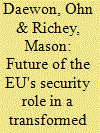

|
|
|
|
|
| Publication |
2012.
|
| Summary/Abstract |
A fundamentally new security landscape is unfolding in East Asia due to the
changing power structure among the great powers, particularly owing to the fast
rise of China and the relative decline of the United States. This paper analyzes the
dynamics of power transition in East Asia and assesses the possibility of the EU
playing a meaningful role in the strengthening of security governance in the
region. It begins by arguing that although the East Asian region is entering a
transformation stage it will not likely lead to a major collision between the United
States and China. This means the EU will have opportunities to become involved
in East Asian security affairs, provided it further strengthens its multi-faceted,
comprehensive engagement policies vis-à-vis the region. We focus particularly
on the EU's ability to promote the positive aspects of East Asian regionalism via
deepened and expanded cooperative measures such as bilateral and multilateral
framework agreements with regional countries and organizations. In addition to
offering a reliable model for regional security governance, the EU will be able to
contribute to regional security by cooperating with the United States and other
East Asian countries and organizations in selected security issues, such as sea-lane
protection, counter-terrorism, non-proliferation of Weapons of Mass Destruction
(WMD), humanitarian operations, etc. Internally, we show that after the Treaty of
Lisbon the EU is approaching incrementally a position wherein it can make
greater CFSP/CSDP engagements-particularly those associated with peacekeeping/
peacemaking and humanitarian operations-in the wider world including East
Asia.
|
|
|
|
|
|
|
|
|
|
|
|
|
|
|
|
| 17 |
ID:
161515


|
|
|
|
|
| Summary/Abstract |
Using a mixed-methods approach, this article surveys and compares how Chinese youth view China’s rise with how their Asian counterparts do. The quantitative analysis uses data from the Asian Student Survey to identify the differences in perception of China’s rise between Chinese and Asian youth. Qualitative interviewing is undertaken to probe and assess the reasons behind the gap. The results show that Chinese youth are more optimistic about political stability and nationalism accompanying China’s rise. Nevertheless, they are open to acknowledge a variety of social problems in the wake of economic growth. With regard to China’s international influence, most Chinese youth have a firm faith in China’s peaceful rise, but they also perceive threats from other countries that are normally ignored in the China threat thesis. Chinese youth tend to attribute the negative evaluations of China among Asian counterparts to external reasons rather than see them as reflections of China’s ‘problematic’ foreign policy. Interview materials show why and how Chinese foreign policy is justified among Chinese young people. They open a door for outsiders to understand Chinese public opinion toward international politics.
|
|
|
|
|
|
|
|
|
|
|
|
|
|
|
|
| 18 |
ID:
165151
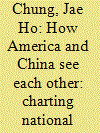

|
|
|
|
|
| Summary/Abstract |
Based on the premise that perception operates either as a catalyst or a constraint for a hegemonic war, this study examines ‘national perceptions’ (i.e. how the citizens of the two states view each other) and ‘official views’ (i.e. how the two governments perceive each other) between the US and China of the post-Cold War period. As for the national views, (1) American perceptions of China have generally become more negative than Chinese perceptions of America; (2) little congruence is found between the two powers on key values and norms; and (3) perceptions are generally getting far ahead of the realities. As for the official views, formal documents do not fully reveal their real state of minds. Diplomatic courtesy and strategic self-esteem runs through them. Yet, America’s strategic concern and growing will to manage China from a position of strength is increasingly more discernible. From the Chinese documents, on the other hand, signs of inferiority have gradually disappeared. In sum, perceptions between the two are working more as a catalyst for strategic competition than a constraint on it.
|
|
|
|
|
|
|
|
|
|
|
|
|
|
|
|
| 19 |
ID:
158887


|
|
|
|
|
| Summary/Abstract |
China’s rise at the global level has been accompanied by a mix of fear, apprehension and caution from some of Beijing’s regional neighbours. While some countries in South Asia and the Asia Pacific region have moved closer to Beijing2, there are others who remain wary of China’s preponderance in the region
|
|
|
|
|
|
|
|
|
|
|
|
|
|
|
|
| 20 |
ID:
144756


|
|
|
|
|
| Summary/Abstract |
Israel’s China policy has traditionally been influenced by Washington’s explicit and perceived pressure. In the early 2010s, Israel started to explore a more independent path in regard to China. In view of global developments, such a change seemed reasonable. However, prevailing conditions prevent Israel from developing an independent China policy.
|
|
|
|
|
|
|
|
|
|
|
|
|
|
|
|
|
|
|
|
|